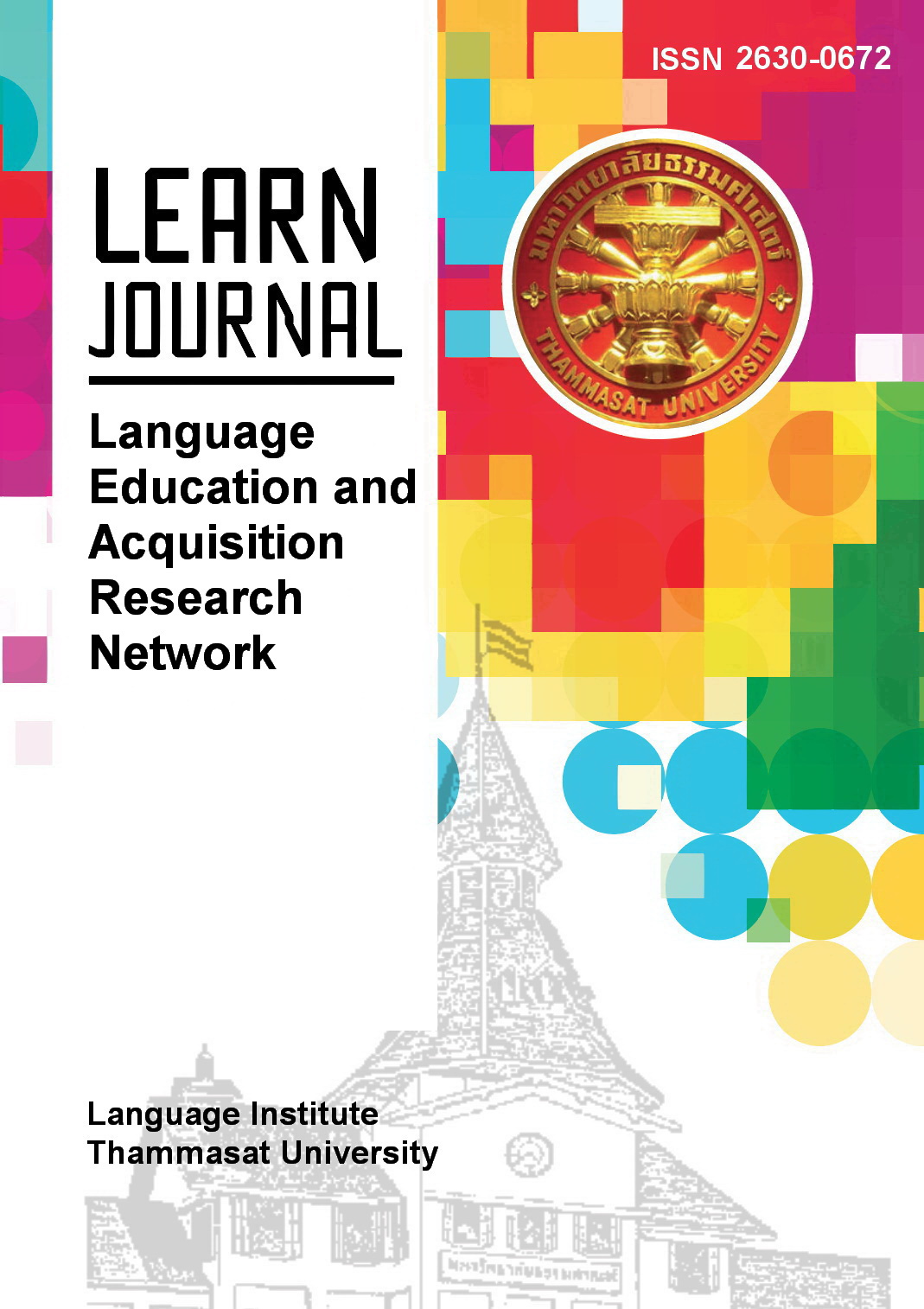Impact of Interpersonal Relations and Positioning on the Resolution of Conflicts in the EFL Classroom
Main Article Content
Abstract
This article is based on the author’s doctoral thesis on the dynamics of interpersonal relations in the onsite classroom. Drawing on positioning theory (Davies & Harré, 1999; Harré, 2015), Sociocultural theory (Vygotsky, 1978; Lantolf & Thorne, 2007) and informed by the focus on interaction in Douglas Fir Group’s seminal paper (Douglas Fir Group (DFG), 2016), the research investigates how students position themselves and their classmates, the explanations for their choices, and how the dynamics of positioning and interpersonal relations affect their opportunities for language learning in group discussions. In this article, the researcher highlights the resolution of conflicts in different scenarios. The fluidity and overlap of positioning found in those interactions not only confirms the impact of interpersonal relations and positioning on resolving conflicts but also the provision and hindrance of students’ opportunities for language learning occurring across contexts and time.
Article Details
References
Breen, M. P. (1998) Navigating the discourse: On what is learned in the
language classroom. In W. A. Renandya, & G. M. Jacobs (Eds.), learners and language learning. anthology (Series 39), 115-144. SEAMEO Regional Language Centre.
Choi, H., & Iwashita, N. (2016) Interactional behaviours of low-proficiency
learners in small group work. In M. Sato, & S. Ballinger (Eds.), Peer interaction and second language learning: Pedagogical potential and research agenda., 113-134. John Benjamins.
Cohen, L., Manion, L., & Morrison, K. (2013). Research methods in
education (7th ed.). Taylor and Francis.
Davies, B., & Harré, R. (1990). Positioning: The discursive production of
selves. Journal for The Theory of Social Behaviour, 20(1), 43–63.
Douglas Fir Group. (2016). A transdisciplinary framework for SLA in a
multilingual world [Supplemental material]. Modern Language
Journal, 100(1), 19– 47. https://doi.org/10.1111/modl.12301.
Ellis, R. (2000). Task-based research and language pedagogy. Language
teaching research, 4(3), 193-220.
Foster, P., & Ohta, A. S. (2005). Negotiation for meaning and peer
assistance in second language classrooms. Applied Linguistics, 26(3), 402-430. https://doi.org/10.1093/applin/ami014.
Harré, R. (2012). Positioning theory: Moral dimensions of social-
cultural psychology. In J. Valsiner (Ed.), The Oxford handbook of
culture and psychology, 191–206. Oxford University Press.
Harré, R. (2015). The person as the nexus of patterns of discursive
practices. Culture & Psychology, 21(4), 492-504. https://doi.org/10.1177/1354067X15615808
Harré, R., & Moghaddam, F. (2003). The self and others: Positioning
individuals and groups in personal, political, and cultural contexts. Praeger.
Harré, R., & Van Langenhove, L. (2010). Varieties of positioning.
In People and societies, 118-132. Routledge.
Herbel-Eisenmann, B. A., Wagner, D., Johnson, K. R., Suh, H., &
Figueras, H. (2015). Positioning in mathematics education: Revelations on an imported theory. Educational Studies in Mathematics, 89(2), 185-204. https://doi.org/10.1007/s10649-014-9588-5.
Hirvonen, P. (2016). Positioning theory and small-group interaction:
Social and task positioning in the context of joint decision-making. Sage Open, 6(3), 1-15. https://doi.org/10.1177/215824401665
Hood, J. G. (2009). Service‐learning in dental education: meeting needs
and challenges. Journal of Dental Education, 73(4), 454-463.
Kim, Y., & McDonough, K. (2008). The effect of interlocutor proficiency
on the collaborative dialogue between Korean as a second language learners. Language Teaching Research, 12(2), 211–234. https://doi.org/10.1177/1362168807086288
Lantolf, J. P., & Thorne, S. L. (2006). Sociocultural theory and the
genesis of second language development. Oxford University Press.
Larsen-Freeman, D. (2010). Having and doing: Learning from a
complexity theory perspective. In P. Seedhouse (Ed.), Conceptualising ‘learning’ in applied linguistics, 52-68. Palgrave Macmillan.
Martin-Beltrán, M., Chen, P. J., Guzman, N., & Merrills, K. (2016). How
adolescents use social discourse to open space for language learning during peer interactions. In M. Sato & S. Ballinger (Eds.), Peer interaction and second language learning: Pedagogical
potential and research agenda, 319-348. John Benjamins.
Moghaddam, F. M., Harré, R., & Lee, N. (2008). Positioning and conflict:
An introduction. In F. M. Moghaddam, R. Harré, & N. Lee (Eds.), Global conflict resolution through positioning analysis, 3-20. Springer Science.
Nunan, D., & Bailey, K. M. (2009). Exploring second language classroom
research: A comprehensive guide. Boston, MA: Heinle, Cengage Learning.
Philp, J., & Adams, R., & Iwashita, N. (2013). Peer interaction and
second language learning (Second language acquisition research series: Theoretical and methodological issues). Taylor & Francis.
Saldaña, J. (2016). The coding manual for qualitative researchers. Sage.
Sato, M., & Ballinger, S. (2016). Peer interaction and second language
learning: pedagogical potential and research agenda. John Benjamins.
Sato, M., & Viveros, P. (2016). Interaction or collaboration: Group
dynamics in the foreign language classroom. In M. Sato, & S. Ballinger (Eds.), Peer interaction and second language learning: Pedagogical potential and research agenda, 99-112. John Benjamins.
Slocum-Bradley, N., & Van Langenhove, L. (2004). The meaning of
regional integration: introducing positioning theory in regional integration studies. Journal of European Integration, 26(3), 227-252. https://doi.org/10.1080/0703633042000261625
Taguchi, N. (2007). Chunk learning and the development of spoken
discourse in a Japanese as a foreign language classroom. Language Teaching Research, 11(4), 433-457. https://doi.org/10.1177/1362168807080962
Toohey, K. (2001). Disputes in child L2 learning. TESOL Quarterly, 35(2),
-278. https://doi.org/10.2307/3587648.
Van Langenhove, L., & Harré, R. (1999). Introducing positioning theory.
In R. Harré & Van Langenhove, L. (Eds.), Positioning theory: Moral contexts of intentional action, 14-31. Blackwell.
Vygotsky, L. S. (1978). Mind in society: The development of higher
psychological processes. Harvard University Press.
Walsh, S. (2011). Exploring classroom discourse: Language in action.
Routledge.
Watanabe, Y., & Swain, M. (2007). Effects of proficiency differences
and patterns of pair interaction on second language learning: Collaborative dialogue between adult ESL learners. Language Teaching Research, 11(2), 121-142. https://doi.org/10.1177/136216880607074599
Yin, R. K. (2012). Applications of case study research (3rd ed.). Sage.
Young, A., & Tedick, D. J. (2016). Collaborative dialogue in a two-way
Spanish/English immersion classroom: Does heterogeneous grouping promote peer linguistic scaffolding? In M. Sato & S. Ballinger (Eds.), Peer interaction and second language learning: Pedagogical potential and research agenda, 135-162. John Benjamins.


